
Acisoma panorpoides, the Asian pintail, trumpet tail, or grizzled pintail, is a species of dragonfly in the family Libellulidae.

Lathrecista asiatica, the asiatic blood tail, is a species of dragonfly in the family Libellulidae. It is the only species in its genus. It is widespread, occurring from India to Australia.
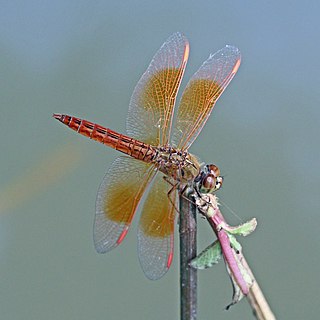
Brachythemis contaminata, ditch jewel, is a species of dragonfly in the family Libellulidae. It is found in many Asian countries.

Bradinopyga geminata is a species of dragonfly in the family Libellulidae known commonly as the granite ghost. It is native to India, Sri Lanka and Thailand, where it is a common and widespread species.

Cratilla lineata, the line forest-skimmer, emerald-banded skimmer or pale-faced forest-skimmer, is a species of dragonfly in the family Libellulidae. It is found in many Asian countries.

Hydrobasileus croceus, the amber-winged marsh glider, is a species of dragonfly in the family Libellulidae. It is a widely distributed species in many Asian countries.

The black marsh skimmer, or light-tipped demon, is a species of dragonfly in the family Libellulidae. It is found in India, Sri Lanka and Thailand.
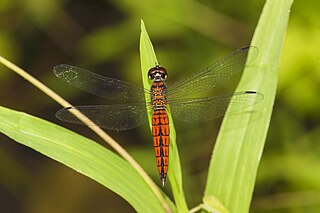
Lyriothemis acigastra or Little Bloodtail is a species of dragonfly in the family of Libellulidae known from India. The International Union for Conservation of Nature also cites very old collections in Burma, China and Tibet.

Microgomphus souteri is a species of small dragonfly in the family Gomphidae. It is endemic to the forest streams of Western Ghats of India.
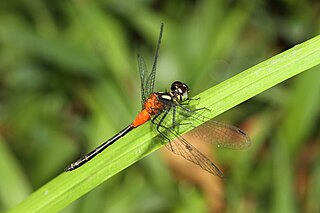
Epithemis mariae is a species of dragonfly in the family Libellulidae known commonly as the rubytailed hawklet. It is endemic to the Western Ghats, India. The species is found in small colonies closely associated with forested marshes.
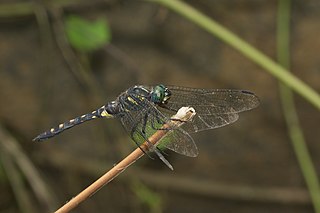
Onychothemis testacea, Stellate river hawk, riverhawker, is a species of dragonfly in the family Libellulidae. It is widespread in many Asian countries.

Macromia flavicincta is a species of dragonfly in the family Macromiidae. It is an endemic dragonfly in India.

Paracercion calamorum, the dusky lilly-squatter, is a species of damselfly in the family Coenagrionidae. It has a range that extends from southern far-eastern Russia to Japan, and to India and Indonesia. The nominate subspecies P. c. calamorum is known from central and eastern China, Korea and Japan. The subspecies P. c. dyeri occurs in southern China, Hong Kong, Taiwan, Indonesia, India, Nepal, and Thailand.

Euphaea cardinalis, Travancore torrent dart, is a species of damselfly in the family Euphaeidae.

Euphaea dispar, Nilgiri torrent dart, is a species of damselfly in the family Euphaeidae.

Euphaea fraseri, Malabar torrent dart, is a species of damselfly in the family Euphaeidae. This species is endemic to the Western Ghats; known to occur in various locations up to Goa.
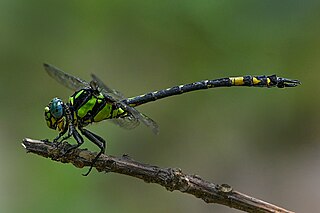
Megalogomphus hannyngtoni, is a species of dragonfly in the family Gomphidae. It is known only from the Western Ghats of India.

Macromia bellicosa is a species of dragonfly in the family Macromiidae. It is an endemic dragonfly and found only in Western Ghats in South India. It breeds in hill streams.

Macromia irata is a species of dragonfly in the family Macromiidae. It is endemic to Western Ghats in India.
























